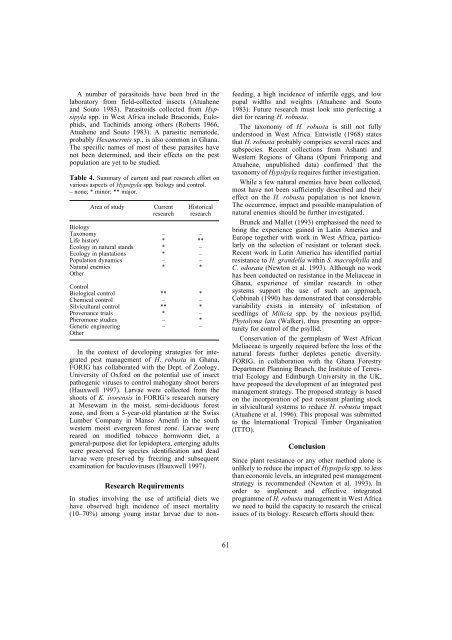Hypsipyla Shoot Borers of Meliaceae in Sri Lanka - Australian ...
Hypsipyla Shoot Borers of Meliaceae in Sri Lanka - Australian ...
Hypsipyla Shoot Borers of Meliaceae in Sri Lanka - Australian ...
Create successful ePaper yourself
Turn your PDF publications into a flip-book with our unique Google optimized e-Paper software.
A number <strong>of</strong> parasitoids have been bred <strong>in</strong> the<br />
laboratory from field-collected <strong>in</strong>sects (Atuahene<br />
and Souto 1983). Parasitoids collected from <strong>Hypsipyla</strong><br />
spp. <strong>in</strong> West Africa <strong>in</strong>clude Braconids, Eulophids,<br />
and Tach<strong>in</strong>ids among others (Roberts 1966,<br />
Atuahene and Souto 1983). A parasitic nematode,<br />
probably Hexamermis sp., is also common <strong>in</strong> Ghana.<br />
The specific names <strong>of</strong> most <strong>of</strong> these parasites have<br />
not been determ<strong>in</strong>ed, and their effects on the pest<br />
population are yet to be studied.<br />
Table 4. Summary <strong>of</strong> current and past research effort on<br />
various aspects <strong>of</strong> <strong>Hypsipyla</strong> spp. biology and control.<br />
– none; * m<strong>in</strong>or; ** major.<br />
Area <strong>of</strong> study Current<br />
research<br />
In the context <strong>of</strong> develop<strong>in</strong>g strategies for <strong>in</strong>tegrated<br />
pest management <strong>of</strong> H. robusta <strong>in</strong> Ghana,<br />
FORIG has collaborated with the Dept. <strong>of</strong> Zoology,<br />
University <strong>of</strong> Oxford on the potential use <strong>of</strong> <strong>in</strong>sect<br />
pathogenic viruses to control mahogany shoot borers<br />
(Hauxwell 1997). Larvae were collected from the<br />
shoots <strong>of</strong> K. ivorensis <strong>in</strong> FORIG’s research nursery<br />
at Mesewam <strong>in</strong> the moist, semi-deciduous forest<br />
zone, and from a 5-year-old plantation at the Swiss<br />
Lumber Company <strong>in</strong> Manso Amenfi <strong>in</strong> the south<br />
western moist evergreen forest zone. Larvae were<br />
reared on modified tobacco hornworm diet, a<br />
general-purpose diet for lepidoptera, emerg<strong>in</strong>g adults<br />
were preserved for species identification and dead<br />
larvae were preserved by freez<strong>in</strong>g and subsequent<br />
exam<strong>in</strong>ation for baculoviruses (Hauxwell 1997).<br />
Research Requirements<br />
Historical<br />
research<br />
Biology<br />
Taxonomy – –<br />
Life history * **<br />
Ecology <strong>in</strong> natural stands * –<br />
Ecology <strong>in</strong> plantations * –<br />
Population dynamics – –<br />
Natural enemies * *<br />
Other<br />
Control<br />
Biological control ** *<br />
Chemical control – –<br />
Silvicultural control ** *<br />
Provenance trials * –<br />
Pheromone studies – *<br />
Genetic eng<strong>in</strong>eer<strong>in</strong>g – –<br />
Other<br />
In studies <strong>in</strong>volv<strong>in</strong>g the use <strong>of</strong> artificial diets we<br />
have observed high <strong>in</strong>cidence <strong>of</strong> <strong>in</strong>sect mortality<br />
(10–70%) among young <strong>in</strong>star larvae due to non-<br />
61<br />
feed<strong>in</strong>g, a high <strong>in</strong>cidence <strong>of</strong> <strong>in</strong>fertile eggs, and low<br />
pupal widths and weights (Atuahene and Souto<br />
1983). Future research must look <strong>in</strong>to perfect<strong>in</strong>g a<br />
diet for rear<strong>in</strong>g H. robusta.<br />
The taxonomy <strong>of</strong> H. robusta is still not fully<br />
understood <strong>in</strong> West Africa. Entwistle (1968) states<br />
that H. robusta probably comprises several races and<br />
subspecies. Recent collections from Ashanti and<br />
Western Regions <strong>of</strong> Ghana (Opuni Frimpong and<br />
Atuahene, unpublished data) confirmed that the<br />
taxonomy <strong>of</strong> <strong>Hypsipyla</strong> requires further <strong>in</strong>vestigation.<br />
While a few natural enemies have been collected,<br />
most have not been sufficiently described and their<br />
effect on the H. robusta population is not known.<br />
The occurrence, impact and possible manipulation <strong>of</strong><br />
natural enemies should be further <strong>in</strong>vestigated.<br />
Brunck and Mallet (1993) emphasised the need to<br />
br<strong>in</strong>g the experience ga<strong>in</strong>ed <strong>in</strong> Lat<strong>in</strong> America and<br />
Europe together with work <strong>in</strong> West Africa, particularly<br />
on the selection <strong>of</strong> resistant or tolerant stock.<br />
Recent work <strong>in</strong> Lat<strong>in</strong> America has identified partial<br />
resistance to H. grandella with<strong>in</strong> S. macrophylla and<br />
C. odorata (Newton et al. 1993). Although no work<br />
has been conducted on resistance <strong>in</strong> the <strong>Meliaceae</strong> <strong>in</strong><br />
Ghana, experience <strong>of</strong> similar research <strong>in</strong> other<br />
systems support the use <strong>of</strong> such an approach.<br />
Cobb<strong>in</strong>ah (1990) has demonstrated that considerable<br />
variability exists <strong>in</strong> <strong>in</strong>tensity <strong>of</strong> <strong>in</strong>festation <strong>of</strong><br />
seedl<strong>in</strong>gs <strong>of</strong> Milicia spp. by the noxious psyllid,<br />
Phytolyma lata (Walker), thus present<strong>in</strong>g an opportunity<br />
for control <strong>of</strong> the psyllid.<br />
Conservation <strong>of</strong> the germplasm <strong>of</strong> West African<br />
<strong>Meliaceae</strong> is urgently required before the loss <strong>of</strong> the<br />
natural forests further depletes genetic diversity.<br />
FORIG, <strong>in</strong> collaboration with the Ghana Forestry<br />
Department Plann<strong>in</strong>g Branch, the Institute <strong>of</strong> Terrestrial<br />
Ecology and Ed<strong>in</strong>burgh University <strong>in</strong> the UK,<br />
have proposed the development <strong>of</strong> an <strong>in</strong>tegrated pest<br />
management strategy. The proposed strategy is based<br />
on the <strong>in</strong>corporation <strong>of</strong> pest resistant plant<strong>in</strong>g stock<br />
<strong>in</strong> silvicultural systems to reduce H. robusta impact<br />
(Atuahene et al. 1996). This proposal was submitted<br />
to the International Tropical Timber Organisation<br />
(ITTO).<br />
Conclusion<br />
S<strong>in</strong>ce plant resistance or any other method alone is<br />
unlikely to reduce the impact <strong>of</strong> <strong>Hypsipyla</strong> spp. to less<br />
than economic levels, an <strong>in</strong>tegrated pest management<br />
strategy is recommended (Newton et al. 1993). In<br />
order to implement and effective <strong>in</strong>tegrated<br />
programme <strong>of</strong> H. robusta management <strong>in</strong> West Africa<br />
we need to build the capacity to research the critical<br />
issues <strong>of</strong> its biology. Research efforts should then:

















